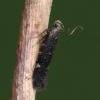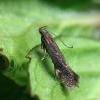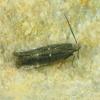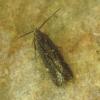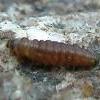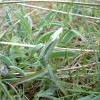35.010 Aproaerema anthyllidella (Hübner, 1813)
Status and Distribution
Local, sometimes locally common throughout most of England and the Channel Islands. Local and mainly coastal in its distribution in Wales, southern Scotland, Northern Ireland and Ireland; rare in northern Scotland and the Isle of Man.

Provisional map
Foodplant and Larval Feeding Signs
Anthyllis vulneraria (kidney vetch), see plant distribution map; also Lathyrus pratensis (meadow vetchling), Lotus corniculatus (common bird's-foot-trefoil), Medicago lupulina (black medick), Medicago sativa (lucerne), Melilotus spp. (melilot), Ononis spp. (restharrow), Onobrychis vicifolia (sainfoin) and Trifolium spp. (clover), including Trifolium campestre (hop trefoil), T. fragiferum (strawberry clover) and T. subterraneum (subterranean clover). A pupa has been found in the shoot of Vicia cracca (tufted vetch). Specific Trifolium and Ononis species have not been found listed in Britain to date other than those listed above.
In Europe also found on Chamaecytisus, Chrysapsis, Coronilla, Dorycnium, Galega officinalis (goat's-rue), Hippocrepis comosa (horseshoe vetch), Ononis campestris, O. repens (common restharrow), O. spinosa (spiny restharrow), Oxytropis pilosa, Phaseolus vulgaris (common bean), Trifolium pratense (red clover), T. repens (white clover) and Trigonella monspeliaca.
White blotches on the leaves of kidney vetch and other Fabaceae develop into podded leaves as the larva grows.
Habitat
Rough ground, dry pastures and sandy coastal areas.
Finding the Moth
Larva: the distinctive white blotches on leaves of the first brood, eventually curling up to form a pod, are readily located on kidney vetch. The early stage mines on unfolded mines need to be checked to exclude fly mines. The second generation has not yet been located feeding on sainfoin or clover but has been found on the flowers and seeds of kidney vetch and in the spun leaves of restharrow. There is also a single August record of a larva on a Melilotus sp. (feeding method and species of melilot not mentioned) and four tenanted mines on common bird's-foot-trefoil in late September.
Adult: can be swept from amongst the foodplant, flies from late afternoon to evening and is attracted to light.
Similar Species
A rather variable species both in size and forewing colouration, ranging from slaty fuscous to blackish fuscous. The yellowish spot in the fold can be absent although it can also be lost in worn specimens and there is some range in the intensity of the yellow ochreous costal and tornal markings from whitish to dull ochreous or even obsolescence.
Consideration needs to be given to other dark-coloured Gelechiids with paler costal and tornal spots. These include Oxypteryx atrella, Oxypteryx immaculatella, Aproaerema albipalpella and Aproaerema sangiella. The yellowish scales in the fold (one third across the forewing, just below the centre), if present, are a useful identification feature although the larger A. sangiella can have some pale scales in this area.
When fresh, the black cilia line in A. anthyllidella is obvious but is easily lost when worn. This line is broader and at the base of the cilia in A. sangiella, and absent in the Oxypteryx species. The male genitalia protrude from the abdomen in A. anthyllidella.
O. atrella has the labial palps completely ochreous with the exception of the lower edge of segment three, which is narrowly fuscous. The other species have combinations of mixed fuscous to purplish fuscous and buffish white. Further details on the palp colouration can be found under O. atrella.
Dissection may sometimes be necessary where particularly poorly marked or worn specimens are concerned.
Double brooded from mid-April to June and July to early October. The peak flight periods are in late May and, with a stronger second appearance, in late July and August. Not infrequent during July in some years.

